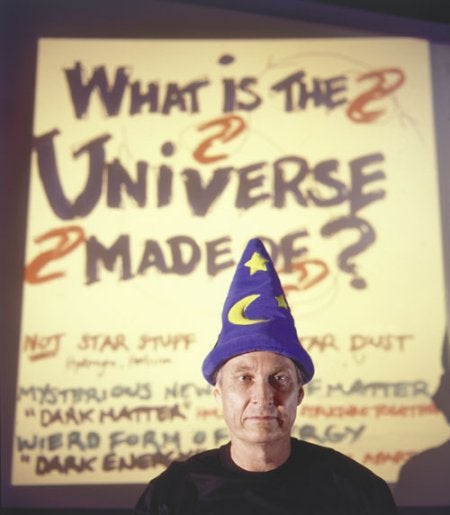This is the widely accepted date of birth for the universe.
Jump ahead
1917
Albert Einstein proposes the existence of a bizarre energy that counteracts gravity and pushes matter apart. Einstein referred to this energy as the cosmological constant. He later retracted this idea, calling it his “biggest blunder.”
1929
Edwin Hubble, using the 100-inch Hooker telescope on Mount Wilson, compares distances of nearby galaxies to their redshifts and discovers that galaxies are moving away from one another. These discoveries lead Hubble to suggest the universe is expanding.
Physicist Wolfgang Pauli proposes a new, unseen, massless, chargeless, hypothetical particle responsible for carrying off missing energy during beta decay.
1933
Eccentric Swiss-American astronomer Fritz Zwicky notices individual members of the Coma cluster were moving too fast to be controlled by the gravity of just their stars. Gravity of unseen dark matter had to be providing the glue that kept the cluster together. He suggests “dark matter” might exist based on the velocities of galaxies in galaxy clusters.
1934
Enrico Fermi coins the term “neutrino,” Italian for “little neutral one.” Fermi’s theory of beta decay describes how a weak nuclear force could make atomic nuclei unstable, producing transformations in subatomic particles. This gains credibility for the neutrino.
1949
Michael Turner is born in Los Angeles, California.
1955
Fred Reines and Clyde Cowan conduct Project Poltergeist and find the first experimental proof of the neutrino’s existence.
1965
Bell Lab scientists Arno Penzias and Robert Wilson discover the cosmic microwave background radiation. Existence of this faint primordial radiation strongly supports a hot Big Bang birth of our universe. It is a revolutionary discovery. In a speech at the Natural History Museum in 1998, Michael Turner classifies the hot Big Bang model as “one of the great intellectual triumphs of the 20th century.”
1967
Turner enrolls at the California Institute of Technology in Pasadena, California.
1970s
Vera Rubin and colleagues show that dark matter holds galaxies together. They conclude that stars and clouds of gas are moving too fast to be held together by the gravity of just their stars. They also found that velocities of clouds did not decrease with increased distance from the center of the galaxy. Their results strongly support the existence of dark matter and brings the dark matter issue “home.”
1971
Michael Turner begins pursuing his Ph.D. at Stanford University.
1973
Turner takes a leave of absence to “find himself.” He ends up finding himself living in a garage, fixing cars, monitoring lab animals, and volunteering for drug experiments at the Palo Alto V.A. Hospital.
1978
Turner successfully defends his dissertation on gravitational waves.
1980
Alan Guth, MIT physicist, proposes the concept of inflation.
David Schramm convinces Turner to come to Chicago as an Enrico Fermi Fellow rather than go to Harvard. Turner is appointed to the faculty of University of Chicago.
1983
David Schramm and Fermilab director Leon Lederman convince NASA to fund an astrophysics group at the lab. They invite Edward “Rocky” Kolb and Michael Turner to lead the new group, which begins a period of “freewheeling inquiry.” The new group is comprised of brilliant and actively curious physicists daring enough to take on the status quo and bring to the front the significance and importance of inflation, cold dark matter, and cosmic microwave background anisotropy.
1984
Michael Turner, Lawrence Krauss, and Gary Steigman attempt to resurrect the cosmological constant.
Mid to late 1980s
Michael Turner hosts “primordial pizza,” which provides an informal environment for the adventurous spirits of the astrophysics group to brainstorm, exchange ideas, and contemplate the absurdity of the universe.
1992
The Cosmic Microwave Background Explorer (COBE) detects tiny temperature fluctuations more than 13 billion years old in the cosmic microwave background radiation. These results give scientists the first glimpse of what the universe was like 400,000 years after its origin.
1995
The Wilkinson Microwave Anisotropy Probe (WMAP) is conceived. Michael Turner and Krauss again argue that the cosmological constant needs to be recognized to provide the mass necessary for a “flat” universe.
1998
In June, astronomers conclude there’s too little matter in the universe to halt expansion, and instead, the expansion of the universe is accelerating!
During a lively debate with Princeton University cosmologist P. James E. Peebles at the National Museum of Natural History in Washington, D.C., Turner suggests that cosmologists, for the first time in history, had a firm grasp on the universe’s origin, evolution, and ultimate fate. Turner indicates that 1998’s successful accounting of matter and energy in the universe is as important a turning point in cosmology as the discovery of the Cosmic Microwave Background was in 1965.
June 2001
WMAP is launched.
February 2003
WMAP reveals the universe is made up of 0.5% visible matter, about 33% dark matter, and about 66% dark energy. This paints a clearer, more detailed picture of the cosmos than the one originally revealed by COBE.










